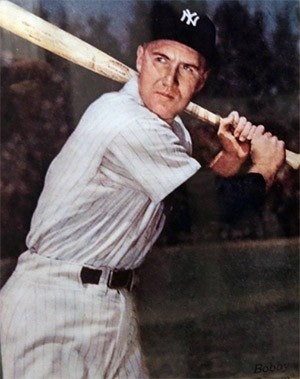Throughout the 2015 baseball season, the George W. Bush Presidential Center is presenting a special exhibit “Baseball: America’s...
Throughout the 2015 baseball season, the George W. Bush Presidential Center is presenting a special exhibit “Baseball: America’s Presidents, America’s Pastime.” The collection of baseball documents and artifacts from presidential libraries is on display at the George W. Bush Presidential Library and Museum until October 4, 2015.
During that time, this blog will interview a variety of people who follow the game closely, including players, baseball executives, historians, and writers. The discussions will look at how baseball intersects with the larger American society, from economics to civil rights to freedom movements and beyond.
Our first interview is with Dr. Bobby Brown, the retired Fort Worth cardiologist. Dr. Brown played third base for the New York Yankees from 1946 through 1954, during which time he played in four World Series. He missed two other World Series because of his military service.
After practicing medicine for nearly three decades, he returned to baseball as president of the American League from 1984 to 1994. In 1974, he served as interim president of the Texas Rangers for six months.
Baseball is the national pastime and the sport has its loyal fans. But the 2015 season started with the game having to renew fan interest, especially in a multi-tasking world. What do you see as baseball’s challenges and road ahead?
Every kid played baseball. They don’t do that now. Baseball is competing with kids who want to play on their phones and who have so many TV options. That’s different than in the past. And kids can do everything in the luxury of air conditioning. They don’t have to get out of the house.
It’s also difficult to put baseball fields in inner cities. Baseball takes a lot of room to play. That’s not so with basketball. It doesn’t take much room to play hoops.
Now, baseball doesn’t have the size problem you have in football. That does help attract some kids to the game. You don’t have to weigh 300 pounds to play or run a 4.2 forty, if you can hit, field and throw. Baseball can find a place for you if you can do those things.
That’s one reason the game has been so popular in the Caribbean. You don’t have to be a big lineman to succeed. The game is a way to get off the islands.
You mention the Caribbean. Baseball really has become a game of nations.
Teams go anywhere they can find the talent.
And what about baseball academies, which teams use to train and develop players? What role do they play in bringing players to the United States and Canada?
They are a major reason baseball has a pipeline of players from places like the Dominican Republic. Major league teams put them in place as a way to get young talent. They sign them as teenagers and see if they can develop into major league players. They not only have a place to play. They have the climate to play in.
Baseball is an international business. When I was serving in the military in Korea in the early 1950s, I would not have believed that one day we would have major league players from Korea.
Do you see the day when Major League Baseball could jump beyond the U.S. and Canada?
Yes, I do. You could get to the point that the Dominican Republic has its own league and teams play there. But I don’t see that in the foreseeable future.
Let’s go back to baseball’s challenges. Like everything else in the American economy, baseball has to worry about putting out a quality product. There’s been a lot written, for example, about speeding up play.
Baseball’s action comes in spurts. Everything is going quiet for a while, and then the guy triples.
But baseball games really don’t take any longer than football games. And you also have dead-time in football games.
Major League Baseball, though, is looking at ways to speed things up.
Yes. And that’s good, although it’s hard to get people to change.
When you bring in a new pitcher, that takes time. When you step out of the batter’s box, that takes time. When you adjust your gloves and take practice swings, that takes time. The only time I got out of the batter’s box was if I didn’t understand a sign or missed one. But that was rare.
You played at the same time as Jackie Robinson. What was that like as baseball finally broke its color line?
The first thing to know is that Jackie could play. He was good. I played with him in the International League for a year. He faced a tough time and put up with it.
When he got to the Brooklyn Dodgers, the club had to find a place for him to stay on road trips. Finally, his teammates got tired of him having to stay in a private home while they stayed at a hotel. They said you need to take him with us. That was a big breakthrough.
Also, before he came into the majors, teams would have a section in the stands for black fans. It was hard to do that when he came in.
He was a tremendous factor in the civil rights movement. And he opened up a flow of talent that had not been in the majors.
Income inequality is an issue in the economy, and baseball has its own wage gap. On the same team, you may have one set of players earning $5 million or more and another set earning $500,000, which is the minimum salary for players. What is your view of this?
Do the math. You have 32 teams and 25 players on each team. That is about 500 players, and they can do what no one else among the billions of people on earth can do. They are paid accordingly.
Also, they are putting more than 40,000 people in the stands during a game. Millions are watching on TV, often on cable networks that the teams own. People pay each month for that cable. It only stands to reason that players are going to get paid well.























